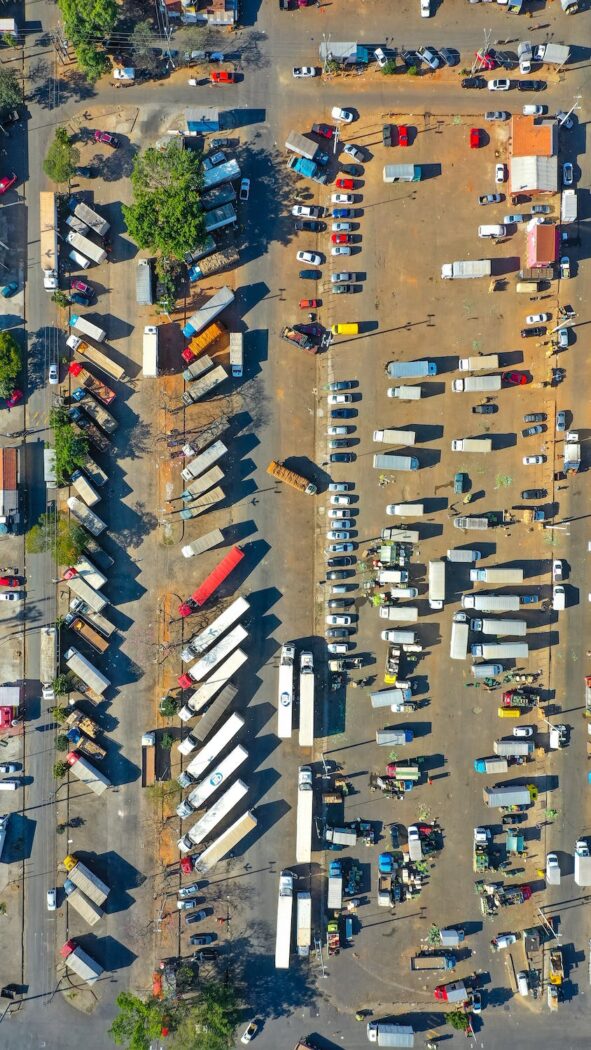Amidst the current surge toward eco-friendly and more dependable methods of cargo transport, the trucking sector continues to stand as a prominent force worldwide, woven into the fabric of daily life. The global count of trucks raises a natural question: How abundant are these vehicles on our roads?
Counting in at approximately 278 million, commercial vehicles populate the world’s transportation landscape, with a significant majority constituting trucks designated for freight conveyance. Beyond this, numerous privately owned trucks contribute to the already substantial tally of trucks worldwide.
To comprehend the rationale behind the sheer multitude of trucks globally, a comprehensive examination is in order. This exploration will delve into major trucking firms, leading truck manufacturers, and the socio-economic implications that trucks exert within significant trucking nations.
The Global Fleet of Trucks
Quantifying the exact number of trucks in existence presents challenges, but a rough estimate places the figure at around 278 million commercial vehicles distributed across twenty major trucking countries. This data is succinctly presented in the following table:
- USA – 141.8 million;
- China – 27 million;
- Japan – 16.4 million;
- Mexico – 10.4 million;
- Indonesia – 9 million;
- Thailand – 7.3 million;
- Brazil – 7.2 million;
- Russia – 7.1 million;
- France – 6.6 million;
- India – 6.4 million;
- Spain – 5.1 million;
- Italy – 4.8 million;
- Turkey – 4.7 million;
- United Kingdom – 4.6 million;
- South Korea – 4.4 million;
- Australia – 3.6 million;
- Poland – 3.5 million;
- Germany – 3.3 million;
- Argentina – 3.2 million;
- South Africa – 3.2 million.
While 278 million may seem substantial, a juxtaposition with global car and bicycle numbers reveals a significant contrast:
- Trucks (commercial vehicles) – 278,000,000;
- Cars – 1,500,000,000;
- Bicycles – 1,000,000,000.
A caveat to bear in mind: the provided truck data only encompasses the top 20 countries.
Titans of Truck Manufacturing
Despite challenges posed by the global COVID-19 pandemic and the drive to curtail carbon emissions, the trucking industry managed a noteworthy resurgence after hitting a two-year nadir in 2019 and 2020. Notably, 2021 saw global truck production soar to 23.2 million units, an astounding increase from the 3 million units recorded during the 2020 trough.
With three major commercial vehicle leaders, including the United States, it’s unsurprising that North America took the lead by producing nearly half of all global commercial vehicles—10.9 million units in 2021. The Asia-Oceania region, while less prolific, saw the production of the heaviest trucks, amassing an estimated 3.3 million units in 2021.
- While the United States boasts six of the world’s most prominent trucking corporations, these giants contributed to a colossal $239.4 billion in truck sales during 2021. Interestingly, European truck manufacturers garnered more revenue from global sales, encompassing sales even within the United States;
- Among these European players, Germany-based Daimler Truck claimed a substantial portion of the market, generating a remarkable $45.2 billion in sales in 2021. Other European manufacturers, including Volvo, Volkswagen, and Paccar, achieved commendable revenues through strategic collaborations with non-European counterparts.
In summation, Germany’s ascendancy as the foremost truck exporter throughout the early 2010s remained unswerving into the 2020s, outpacing second-place Mexico by an estimated 9 million units.
The Reigning Truck Haven
In the realm of trucks, the United States takes an unequivocal lead, boasting the highest truck count globally. This towering count dwarfs China’s second-place position, with the United States sporting a truck populace at least five times larger.
While dissecting the reasons behind America’s truck supremacy proves intricate, socio-economic and geographical factors both play pivotal roles in this narrative.
Socio-Economic Threads of American Trucking
Approximately 72.5% of America’s cargo mass relies on trucks for transport, a staggering statistic considering the nation’s expansive size and population exceeding 300 million. This dependency intertwines trucking logistics with the economy, profoundly influencing the socio-economic tapestry of daily and commercial life. Noteworthy statistics further underscore this connection:
- Trucking contributed a hefty $732.3 billion in gross freight revenues in 2020, constituting over 80% of America’s total freight revenue;
- Commercial truck use translated to tax revenues surpassing $48.6 billion in federal and state-highway taxes during 2019, representing 14.4% of all registered vehicles;
- Diesel fuel consumption reached 36.5 billion gallons, subject to a federal tax rate of 24.4 cents per gallon and a state tax rate of 30.3 cents per gallon;
- Gasoline consumption tallied at 9.1 billion gallons, with federal and state fuel tax rates at 18.4 cents and 28.5 cents per gallon, respectively;
- The trucking industry employed 7.65 million individuals, excluding self-employed personnel.
The Geography of American Trucking
Owing to its extensive landmass and dominant global economy, the United States relies heavily on trucking to ensure a continuous flow of goods. This reliance stems from the country’s robust road networks and early adoption of such infrastructure. While alternative transit methods exist, such as air travel, maritime shipping, and rail transport, the nation’s sheer size renders these insufficient.
Moreover, America’s closely monitored borders with Canada and Mexico witness substantial import and export activities conducted through trucks:
- In 2020, trucks facilitated 70.9% of the value of surface trade between the United States and Canada;
- In the same year, trucks were responsible for 83.3% of the value of surface trade between the United States and Mexico.
This international trade dynamic resulted in advanced trucking enterprises, logistics networks, sales revenues, and manufacturing facilities flourishing in both Canada and Mexico.

Final Reflections
In conclusion, the world of trucking, with its towering fleets and intricate interconnections, stands as an emblem of resilience and adaptability. Amidst the pressing tide of environmental consciousness and evolving transportation technologies, the trucking industry remains a steadfast protagonist, charting its course through the shifting currents of global trade and commerce.
- From the bustling highways of the United States to the bustling streets of China, trucks symbolize more than just metal and mechanics. They represent the ceaseless movement of goods, aspirations, and economies. The numbers, staggering as they are, merely scratch the surface of a multifaceted narrative that encompasses manufacturers’ innovations, intricate supply chains, and the livelihoods of millions of people;
- As the 2020s unfold, the trucking industry finds itself at a crossroads, poised between tradition and innovation. It must navigate the complexities of a changing world, embracing technological advancements while preserving the human touch that underpins its essence.
Ultimately, the global fleet of trucks is more than a mere statistic; it’s a testament to human ingenuity, endurance, and the ever-persistent drive to connect societies, fuel economies, and make the world go round. As the landscape evolves, one thing remains certain: the rumble of truck engines will continue to resonate, harmonizing the symphony of a world in motion.











